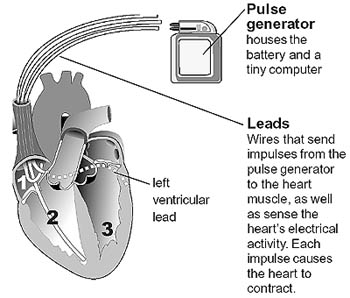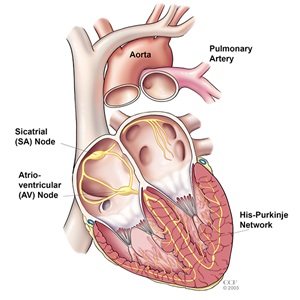What is cardiac resynchronization therapy?
- Cardiac resynchronization therapy (CRT) is used to treat the delay in heart ventricle contractions that occur in some people with advanced heart failure

- Heart failure means the heart's pumping power is weaker than normal. With heart failure, blood moves through the heart and body at a slower rate, and pressure in the heart increases. A delay between the contraction of the right and left ventricles often occurs with heart failure, so the walls of the left ventricle are unable to contract at the same time.
- The CRT pacing device (also called a biventricular pacemaker) is an electronic, battery-powered device that is surgically implanted under the skin.
- The device has 2 or 3 leads (wires) that are positioned in the heart to help the heart beat in a more balanced way. The leads are implanted through a vein in the right atrium and right ventricle and into the coronary sinus vein to pace the left ventricle.
How it works:
When your heart rate drops below the set rate (programmed by your doctor), the device generates (fires) small electrical impulses that pass through the leads to the heart muscle. These impulses make the lower chambers (ventricles) of the heart muscle contract, causing the right and left ventricles to pump together. The end result is improved cardiac function.
CRT Device
The CRT device (biventricular pacemaker) has 2 or 3 leads that are positioned in the:
- Right atrium
- Right ventricle
- Left ventricle (via the coronary sinus vein)

Electrical system of the heart
The atria and ventricles work together, alternately contracting and relaxing to pump blood through the heart. The electrical system of the heart is the power source that makes this possible.
Normally, the electrical impulse begins at the sinoatrial (SA) node, located in the right atrium. The electrical activity spreads through the walls of the atria, causing them to contract.
Next, the electrical impulse travels through the AV node, located between the atria and ventricles. The AV node acts like a gate that slows the electrical signal before it enters the ventricles. This delay gives the atria time to contract before the ventricles do. From the AV node, the electrical impulse travels through the His-Purkinje network, a pathway of specialized electricity- conducting fibers. Then the impulse travels into the muscular walls of the ventricles, causing them to contract. This sequence occurs with every heartbeat (usually 60-100 times per minute).
Who is Eligible to Receive a CRT Device?
People with heart failure who have a poor ejection fraction (<35%) are at risk for fast, irregular and sometimes life- threatening heart rhythms. Ejection fraction is the measurement of how much blood is being pumped out of the left ventricle of the heart. CRT may be appropriate for people who:
- Have severe or moderately severe heart failure symptoms
- Are taking medications to treat heart failure
- Have delayed electrical activation of the heart (such as intraventricular conduction delay or bundle branch block)
- Have a history of cardiac arrest or are at risk for cardiac arrest
Together, you and your doctor will determine if this treatment is right for you. You will receive an instruction sheet that describes how to prepare for the procedure. Here’s an overview of those instructions.


